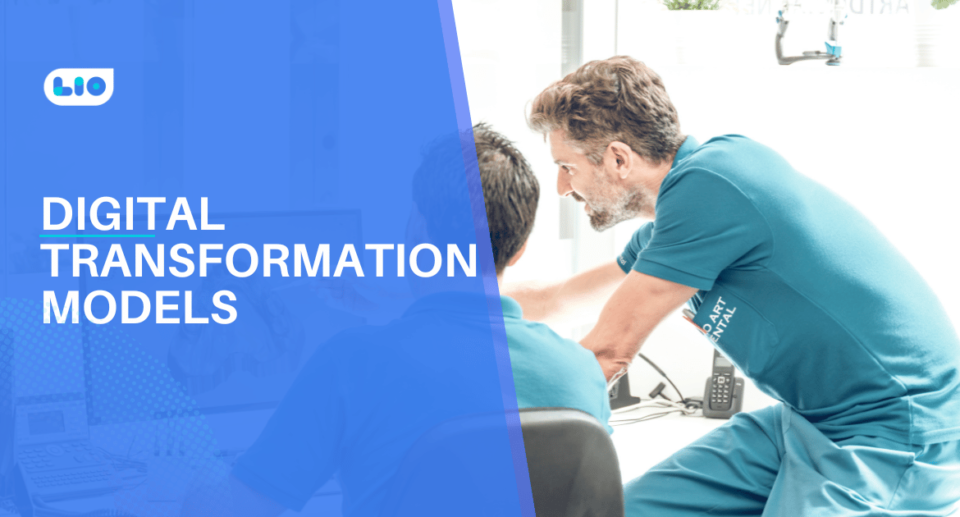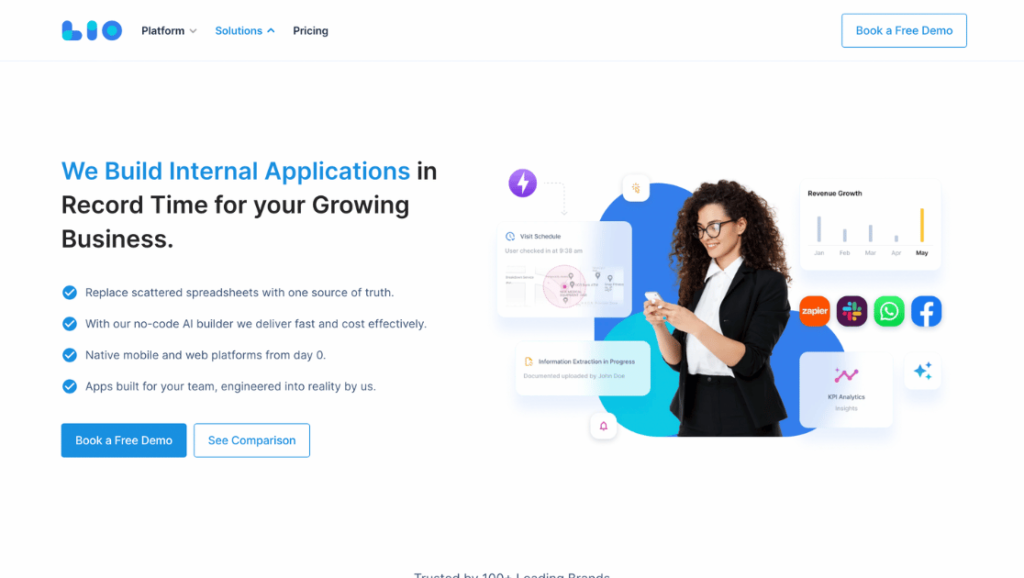Digital Transformation Models: A Comprehensive Guide for Businesses
Gaurav Singh Rawat
- April 9, 2025
- 17 Min Read

Digital transformation is the integration of digital technology into all areas of a business, fundamentally changing how it operates and delivers value to customers. It’s not just about adopting new technologies; it’s a cultural change that requires organizations to continually challenge the status quo, experiment, and get comfortable with failure.
The digital transformation journey involves rethinking old operating models, becoming more agile in responding to customer needs and market dynamics, and finding new ways to create value. It’s a complex process that touches every aspect of an organization, from its internal processes and employee experiences to its customer interactions and business models.
Digital transformation has become a critical imperative for organizations across all industries. As companies strive to remain competitive and relevant in an increasingly digital world, understanding and implementing effective digital transformation models has become essential. This comprehensive guide will explore the concept of digital transformation models, their importance, various types, and strategies for successful implementation.
Why Digital Transformation Matters
In today’s digital age, businesses that fail to adapt risk becoming obsolete. Here’s why digital transformation matters:
- Staying Competitive: As more companies embrace digital technologies, those that don’t risk falling behind their competitors.
- Improving Customer Experience: Digital transformation enables businesses to better understand and serve their customers through data-driven insights and personalized experiences.
- Enhancing Operational Efficiency: By automating processes and leveraging data analytics, organizations can streamline operations and reduce costs.
- Driving Innovation: Digital transformation fosters a culture of innovation, enabling companies to develop new products, services, and business models.
- Adapting to Market Changes: Digitally transformed organizations are more agile and better equipped to respond to market shifts and customer demands.

Digitize for Success
Take your business to the next level with digital transformation. Our expert team will help you integrate digital technologies, improve customer engagement, and create new revenue streams. Start your digital success story today!
The Impact of COVID-19 on Digital Transformation
The COVID-19 pandemic has significantly accelerated the need for digital transformation across industries. As businesses were forced to adapt to remote work and changing consumer behaviors, many realized the importance of having robust digital capabilities. This global crisis has:
- Accelerated Digital Initiatives: Many companies fast-tracked their digital transformation plans to ensure business continuity.
- Highlighted the Importance of Cloud Technologies: Cloud-based solutions became crucial for enabling remote work and maintaining operations.
- Shifted Consumer Behaviors: The pandemic led to a surge in e-commerce and digital service adoption, forcing businesses to enhance their digital offerings.
- Emphasized the Need for Agility: Organizations with flexible, digitally-enabled operations were better positioned to navigate the crisis.

What is a Digital Transformation Model?
A digital transformation model serves as a framework or roadmap for organizations to plan and execute their digital transformation initiatives. These models provide a structured approach to integrating digital technologies, processes, and strategies across an organization.
Digital transformation models help businesses:
- Assess Current State: Evaluate the organization’s current digital maturity and capabilities.
- Set Clear Objectives: Define specific goals and outcomes for the transformation process.
- Plan Strategically: Develop a step-by-step approach to implementing digital initiatives.
- Align Efforts: Ensure that transformation efforts are coordinated across different departments and aligned with overall business objectives.
- Measure Progress: Establish metrics and benchmarks to track the success of transformation initiatives.
7 Types of Digital Transformation Models
Digital transformation models serve as frameworks to guide organizations through their digital evolution. These models provide structured approaches to implementing digital initiatives, helping businesses navigate the complexities of technological change. Here are some of the most prominent types of digital transformation models:

Go Paperless Today
Transform your business with Lio. Digitize your documents and workflows to eliminate paper clutter and boost efficiency. Start your paperless journey now!
Horizon-based Models
Horizon-based models, such as McKinsey’s Three Horizons of Growth, break down digital transformation initiatives into distinct phases or “horizons.” Each horizon focuses on specific timeframes, priorities, and objectives:
- Horizon 1: This phase typically involves auditing and optimizing existing technologies and processes. The focus is on improving current operations and laying the groundwork for future transformation.
- Horizon 2: In this stage, organizations invest in emerging opportunities and enhance existing strengths. This might involve piloting new technologies or expanding digital capabilities in key areas of the business.
- Horizon 3: The final horizon focuses on long-term growth and innovation. This is where organizations explore disruptive technologies and business models that could reshape their industry.
This model helps organizations balance short-term improvements with long-term strategic goals, ensuring a comprehensive approach to digital transformation.

Capability Maturity Frameworks
Capability maturity frameworks assess an organization’s readiness for digital transformation across various domains. These models typically define stages of maturity, from basic to advanced, in areas such as:
- Data utilization
- Technology adoption
- Digital skills and talent
- Customer experience
- Operational processes
By evaluating their current maturity level in each area, organizations can identify gaps and prioritize improvement efforts. This approach ensures a balanced transformation that addresses all critical aspects of the business.
Staged Roadmap Models
Staged roadmap models break down the digital transformation journey into sequential steps or stages. Each stage has defined objectives, milestones, and timelines. A typical staged roadmap might include:
- Assessment: Evaluating current digital capabilities and identifying transformation goals.
- Planning: Developing a detailed strategy and prioritizing initiatives.
- Implementation: Executing digital projects and initiatives.
- Optimization: Refining and improving implemented solutions.
- Scaling: Expanding successful initiatives across the organization.
This model provides a clear, step-by-step approach to transformation, making it easier for organizations to manage complex change processes.
Business Architecture Frameworks
Business architecture frameworks align digital transformation initiatives with broader business goals and capabilities. These models typically involve:
- Mapping the organization’s current business architecture
- Identifying key business capabilities and processes
- Aligning digital initiatives with strategic objectives
- Ensuring that new technologies and processes integrate seamlessly with existing systems
By using a business architecture approach, organizations can ensure that their digital transformation efforts are closely tied to business value and strategic priorities.

Transform Your Business
Stay ahead in the digital age. Explore our proven digital transformation models and learn how to revolutionize your operations, enhance customer experience, and drive innovation.
Taxonomy-based Models
Taxonomy-based models use classification systems to categorize, organize, and prioritize digital transformation initiatives. These models might classify projects based on:
- Business impact (e.g., cost reduction, revenue growth, customer satisfaction)
- Technology domain (e.g., cloud computing, artificial intelligence, Internet of Things)
- Organizational function (e.g., marketing, operations, human resources)
- Level of innovation (e.g., incremental improvement, disruptive change)
This approach helps organizations create a balanced portfolio of digital initiatives and ensures that transformation efforts address all key areas of the business.
Strategic Pillar Models
Strategic pillar models focus on core areas or “pillars” that are critical to an organization’s digital transformation. Common pillars might include:
- Customer Experience
- Operational Efficiency
- Data and Analytics
- Innovation and New Business Models
- Digital Culture and Skills
Organizations develop strategies and initiatives for each pillar, ensuring a comprehensive approach to transformation. This model helps maintain focus on key strategic priorities throughout the transformation journey.

Lifecycle Evolution Models
Lifecycle evolution models view digital transformation as an ongoing, iterative process rather than a one-time initiative. These models typically include stages such as:
- Initiation: Recognizing the need for digital transformation and building awareness.
- Development: Planning and implementing initial digital initiatives.
- Growth: Scaling successful initiatives and expanding digital capabilities.
- Maturity: Achieving advanced digital capabilities across the organization.
- Renewal: Continuously adapting to new technologies and market changes.
This approach emphasizes the need for ongoing adaptation and evolution in response to rapidly changing digital landscapes.
5 Most Popular Digital Transformation Models
Several digital transformation models have gained prominence in recent years. Each model offers a unique perspective and approach to guiding organizations through their digital transformation journey. Let’s explore some of the most widely used models:
McKinsey 7S Model
The McKinsey 7S Model is a holistic approach that focuses on seven interdependent elements that need to be aligned for successful transformation:
- Strategy: The plan to build and maintain competitive advantage.
- Structure: How the organization is structured and who reports to whom.
- Systems: The daily activities and procedures staff members engage in to get the job done.
- Shared Values: The core values of the company that are evidenced in the corporate culture and general work ethic.
- Style: The style of leadership adopted.
- Staff: The employees and their general capabilities.
- Skills: The actual skills and competencies of the employees working for the company.
This model emphasizes that all seven elements must be aligned and mutually reinforcing for effective organizational change.

Embrace Digital Innovation
Don't get left behind in the digital race. Our transformation models will help you embrace innovation, streamline processes, and create new value for your customers and stakeholders.
ADKAR Model
The ADKAR Model, developed by Prosci, focuses on the individual and organizational aspects of change management in digital transformation. ADKAR stands for:
- Awareness: Understanding why change is necessary.
- Desire: Having the motivation to support and participate in the change.
- Knowledge: Knowing how to change.
- Ability: Having the skills and behaviors needed to implement the change.
- Reinforcement: Sustaining the change over time.
This model is particularly useful for addressing the human side of digital transformation, ensuring that employees are prepared for and supportive of the changes.
Kotter's 8-Step Model
Developed by John Kotter, this model provides eight steps for leading organizational change:
- Create a sense of urgency
- Build a guiding coalition
- Form a strategic vision and initiatives
- Enlist a volunteer army
- Enable action by removing barriers
- Generate short-term wins
- Sustain acceleration
- Institute change
Kotter’s model emphasizes the importance of creating momentum and building support for change throughout the organization.

Digital Maturity Model
The Digital Maturity Model assesses an organization’s readiness and progress in terms of digital capabilities. It typically includes stages such as:
- Initiation: Beginning to explore digital technologies.
- Experimentation: Piloting digital initiatives in specific areas.
- Scaling: Expanding successful digital initiatives across the organization.
- Integration: Integrating digital capabilities into core business processes.
- Optimization: Continuously improving and innovating digital capabilities.
This model helps organizations understand where they are in their digital journey and what steps they need to take to advance.
Crawl, Walk, Run Model
The Crawl, Walk, Run Model suggests a phased approach to digital transformation:
- Crawl: Start with small, manageable initiatives to build confidence and capabilities.
- Walk: Gradually move to more significant changes and broader implementation.
- Run: Achieve full-scale transformation and continuous innovation.
This model is particularly useful for organizations that may be overwhelmed by the prospect of large-scale change, allowing them to build momentum gradually.
Factors to Consider When Choosing a Digital Transformation Model
Selecting the right digital transformation model is crucial for the success of your organization’s digital journey. Each business has unique needs, challenges, and goals, so it’s essential to choose a model that aligns with your specific circumstances. Here are the key factors to consider when selecting a digital transformation model:

Organizational Maturity
The current digital maturity of your organization plays a significant role in determining which model is most appropriate:
- Assessment: Evaluate your organization’s current digital capabilities, processes, and culture.
- Readiness: Consider whether your organization is prepared for significant change or if a more gradual approach is needed.
- Existing Infrastructure: Assess your current technology stack and its ability to support new digital initiatives.
Organizations with higher digital maturity may be better suited for more advanced models, while those at earlier stages might benefit from models that focus on building foundational capabilities.
Business Objectives and Strategy
Your digital transformation model should align closely with your overall business strategy:
- Strategic Goals: Identify the primary objectives of your digital transformation efforts (e.g., improving customer experience, increasing operational efficiency, developing new revenue streams).
- Industry Context: Consider industry-specific challenges and opportunities that may influence your transformation approach.
- Competitive Landscape: Assess how digital transformation can give you a competitive edge in your market.
Choose a model that supports your strategic priorities and helps you achieve your business objectives.

Start Your Digital Journey
Ready to transform your business? Discover how our digital transformation models can guide you to success. Take the first step towards a more efficient, innovative future today.
Organizational Culture and Change Readiness
The success of digital transformation heavily depends on your organization’s culture and willingness to change:
- Cultural Assessment: Evaluate your organization’s openness to innovation and risk-taking.
- Change Management Capabilities: Consider your organization’s track record with implementing large-scale changes.
- Leadership Support: Assess the level of buy-in and support from top management for digital initiatives.
Models that emphasize cultural change and employee engagement may be more suitable for organizations that need to overcome resistance to change.
Resource Availability
The resources at your disposal will influence the type of model you can effectively implement:
- Budget: Consider the financial resources available for digital transformation initiatives.
- Talent: Assess the skills and expertise of your current workforce and the ability to attract new talent.
- Time: Evaluate the urgency of your transformation needs and the time frame available for implementation.
Organizations with limited resources may need to choose models that allow for a more phased or incremental approach to transformation.
Technology Landscape
The technological context of your organization and industry should inform your choice of model:
- Current Technology Stack: Evaluate how well your existing systems can integrate with new digital solutions.
- Emerging Technologies: Consider which emerging technologies (e.g., AI, IoT, blockchain) are most relevant to your industry and business goals.
- Data Capabilities: Assess your organization’s ability to collect, analyze, and leverage data effectively.
Choose a model that helps you leverage your technological strengths and addresses your weaknesses.
Customer Needs and Expectations
Your digital transformation should ultimately serve your customers better:
- Customer Insights: Use data and feedback to understand your customers’ evolving needs and preferences.
- Industry Benchmarks: Compare your digital capabilities to customer expectations in your industry.
- Future Trends: Anticipate future changes in customer behavior and expectations.
Models that emphasize customer-centricity may be more appropriate for organizations looking to improve their customer experience significantly.

Scalability and Flexibility
Consider how well the model can adapt to future changes and growth:
- Scalability: Assess whether the model can support your organization as it grows and expands.
- Adaptability: Consider how easily the model can be adjusted to accommodate new technologies or market changes.
- Long-term Viability: Evaluate whether the model will remain relevant as digital technologies continue to evolve.
Choose a model that provides a framework for ongoing digital evolution rather than a one-time transformation.
Regulatory Environment
The regulatory landscape in your industry can significantly impact your digital transformation approach:
- Compliance Requirements: Consider any industry-specific regulations that may affect your digital initiatives.
- Data Privacy Laws: Assess how data protection regulations (e.g., GDPR, CCPA) may influence your digital strategy.
- Industry Standards: Consider any industry-specific standards or best practices for digital technologies.
Ensure that the chosen model allows for compliance with relevant regulations and standards.
Ecosystem and Partnerships
Consider how the model facilitates collaboration with external partners and stakeholders:
- Partner Ecosystem: Evaluate your current and potential partnerships with technology vendors, consultants, and other stakeholders.
- Industry Collaboration: Consider opportunities for collaboration within your industry or across sectors.
- Open Innovation: Assess how the model supports open innovation and external collaboration.
Models that emphasize ecosystem development may be more suitable for organizations looking to leverage external partnerships for innovation.
How can Lio help in Digital Transformation
Lio can play a pivotal role in helping businesses transition from paper-based processes to a fully digital and automated environment. Here are some ways Lio can facilitate this digital transformation:

Centralized Data Management
Lio provides a platform where businesses can store all their data in a centralized digital repository. This eliminates the need for physical documents and allows for easy access, management, and sharing of information.
Customizable Templates
Lio offers a variety of customizable templates that can be tailored to fit the specific needs of different business processes. Whether it’s for inventory management, customer records, or financial tracking, these templates help digitize and streamline operations.
Real-Time Collaboration
The platform supports real-time collaboration, enabling multiple users to work on the same document simultaneously. This feature is particularly useful for teams that need to coordinate and update information frequently, reducing the reliance on paper-based communication.
Mobile Accessibility
Lio is accessible via mobile devices, allowing employees to input and access data from anywhere. This mobility ensures that business operations can continue smoothly without the constraints of physical paperwork.

Go Paperless Today
Transform your business with Lio. Digitize your documents and workflows to eliminate paper clutter and boost efficiency. Start your paperless journey now!
Secure Document Management
Lio provides robust security features to protect sensitive business data. Documents can be locked to prevent unauthorized edits, and access can be controlled through user permissions, ensuring that only authorized personnel can view or modify critical information.
Automated Workflows
The platform supports the creation of automated workflows, which can replace manual, paper-based processes. For example, approval processes, data entry, and reporting can be automated, reducing the time and effort required to manage these tasks manually.
Integration with Existing Systems
Lio can integrate with over 100 existing applications, allowing businesses to connect their new digital solutions with current systems. This seamless integration ensures that the transition to a paperless environment does not disrupt existing workflows.
Conclusion
Digital transformation is no longer a luxury but a necessity for businesses looking to thrive in the digital age. By understanding and implementing effective digital transformation models, organizations can navigate the complexities of change, leverage new technologies, and create value in innovative ways.
The journey of digital transformation is ongoing and requires a commitment to continuous learning and adaptation. As technologies evolve and customer expectations shift, businesses must remain agile and open to new possibilities.
By embracing digital transformation, organizations can not only survive but thrive in an increasingly digital world, creating new opportunities for growth, efficiency, and innovation. The key lies in developing a clear strategy, fostering a culture of innovation, and remaining focused on delivering value to customers and stakeholders.
As you embark on or continue your digital transformation journey, remember that success is not just about implementing new technologies, but about fundamentally reimagining how your business operates in the digital age. With the right approach, mindset, and tools, your organization can unlock its full potential and lead in the digital era.
Frequently Asked Questions (FAQs)
How do digital transformation models differ from digital strategies?
While a digital strategy outlines the overall vision and goals for digital initiatives, a digital transformation model provides a structured approach to achieving those goals. The model includes specific steps, methodologies, and tools to implement the strategy effectively.
Can digital transformation models be customized for different industries?
Yes, digital transformation models can and should be customized to fit the unique needs and challenges of different industries. Factors such as regulatory requirements, customer expectations, and technological advancements vary across industries, necessitating tailored approaches.
What role do employees play in digital transformation models?
Employees are crucial to the success of digital transformation. Models often include components for change management, training, and engagement to ensure that employees are prepared for and supportive of the transformation. Their buy-in and adaptability are essential for successful implementation.
How do you measure the success of a digital transformation model?
Success can be measured using various metrics, including:
- Customer satisfaction and engagement levels
- Operational efficiency improvements
- Revenue growth from digital initiatives
- Employee adoption and proficiency with new technologies
- Achievement of strategic goals and KPIs
What are some common challenges in implementing digital transformation models?
Common challenges include:
- Resistance to change from employees and management
- Integration issues with legacy systems
- Budget constraints and resource allocation
- Ensuring data security and compliance
- Aligning digital initiatives with overall business strategy
How do digital transformation models address cybersecurity concerns?
Effective digital transformation models incorporate robust cybersecurity measures to protect data and systems. This includes implementing advanced security protocols, regular audits, employee training on cybersecurity best practices, and compliance with relevant regulations.
What is the role of leadership in digital transformation models?
Leadership plays a pivotal role in driving digital transformation. Leaders must champion the transformation efforts, allocate necessary resources, communicate the vision and benefits, and foster a culture of innovation and adaptability within the organization.
How do digital transformation models handle legacy systems?
Models often include strategies for integrating or modernizing legacy systems. This can involve using middleware to connect old and new systems, gradually phasing out outdated technologies, or adopting cloud-based solutions to enhance scalability and flexibility.


